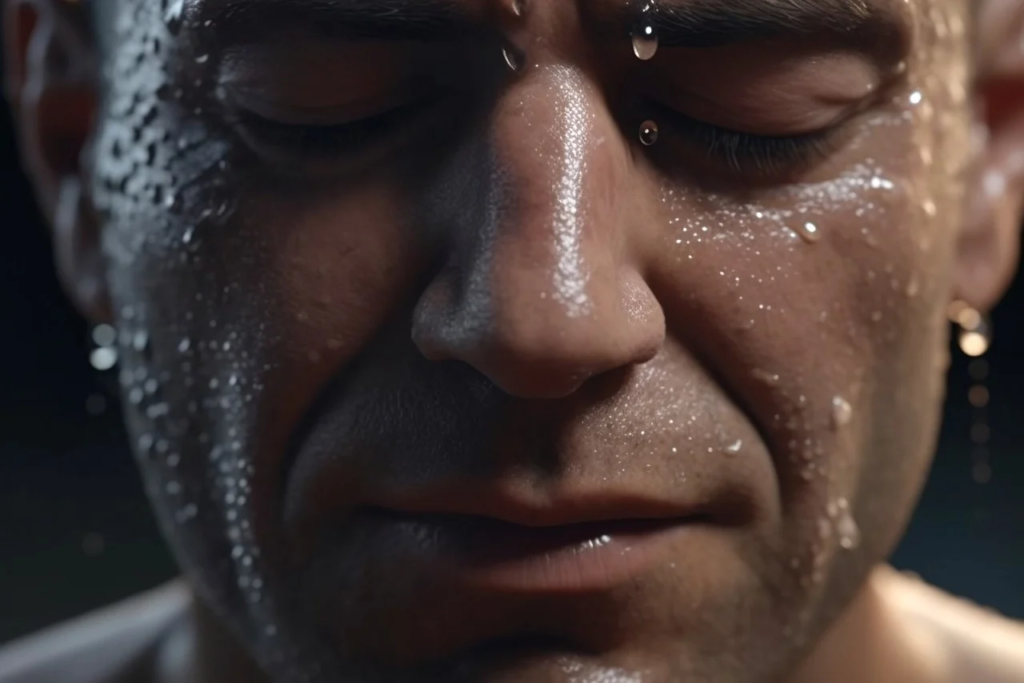Saunas are supposed to be sweat fests, but what if you’re the only one staying dry? Don’t panic! This post explores Why am I not sweating in the sauna?. and offers helpful tips to get your sweat flowing and maximize your sauna experience. Let’s unlock the sauna sweat secrets!
Why am I not sweating in the sauna?
The Sauna Sweat Mystery: Why You Might Not Be Breaking a Sweat (and What to Do About It)
Saunas are a haven of relaxation and rejuvenation. Stepping into a hot, enclosed space and letting your worries melt away with the sweat is a common experience. But what if you find yourself in a sauna surrounded by glistening bodies and feel strangely dry? Fear not, fellow sauna enthusiast! Not sweating in a sauna doesn’t necessarily mean something is wrong. There are several reasons why this might happen, and most of them are easily addressed.

Is It Normal Not to Sweat in a Sauna?
Absolutely! While sweating is the body’s natural response to heat, some factors can influence how much you sweat and how quickly you start sweating. Here’s a breakdown of the key reasons why you might not be experiencing a full-on sweat session:
- Dehydration: Sweat is mostly water, so if you’re dehydrated, your body prioritizes conserving fluids over cooling itself down. This can lead to reduced sweating, even in hot environments like saunas.
- Sauna Temperature: Saunas come in two main varieties: traditional and infrared. Traditional saunas use dry heat, reaching temperatures between 150-195°F (65-90°C). Infrared saunas use radiant heat, operating at slightly lower temperatures (120-140°F, 49-60°C). If you’re in an infrared sauna or a traditional sauna on the lower end of the temperature spectrum, your body may not perceive the need to sweat as intensely.
- Other Factors: Certain medications, like diuretics and beta-blockers, can affect sweat production. Electrolyte imbalances, particularly low sodium and potassium levels, can also hinder sweating. Genetics play a role too – some people naturally have less active sweat glands. As we age, sweat gland activity tends to decrease as well.

Case Study: The Sauna Newbie
Sarah, a fitness enthusiast, decided to try out the sauna for the first time. She entered the sauna feeling a bit warm but not hot. After 10 minutes, she noticed everyone around her was sweating profusely, while she felt relatively dry. This experience might be due to a few factors. As a sauna newbie, her body might still be adjusting to the heat and hasn’t reached its peak sweating response yet. Additionally, if the sauna was on the lower end of the temperature range, it might not have been hot enough to trigger a significant sweat response in Sarah.
What Happens If You Don’t Sweat in a Sauna?
While sweating is a classic sauna experience, it’s not essential to reap the benefits. Here’s a closer look at what happens (or doesn’t happen) when you don’t sweat in a sauna:
- Body Cooling: The primary function of sweating is to cool the body down. When you don’t sweat, your body temperature may rise slightly faster than someone who sweats readily. However, saunas are controlled environments, and the risk of overheating is minimal if you follow the recommended time limits and listen to your body.
- Reduced Toxin Release: Sweating is often associated with toxin release. However, sweat is primarily composed of water, electrolytes, and waste products like urea. While sweating may contribute slightly to toxin elimination, it’s not the main pathway for detoxification. Your liver and kidneys are the primary organs responsible for removing toxins from the body.
- Relaxation and Other Benefits: The sauna offers a range of benefits beyond just sweating. The heat promotes relaxation by easing muscle tension and improving circulation. Studies have shown that saunas can also help with pain management, reduce inflammation, and improve cardiovascular health.
Table 1: Sauna Benefits: Sweat vs. No Sweat
| Benefit | Sweat | No Sweat |
|---|---|---|
| Body Cooling | The primary mechanism for cooling | The temperature may rise slightly faster |
| Toxin Release | Minor contribution | The liver and kidneys are the primary detoxification organs |
| Relaxation | Heat promotes relaxation and muscle tension relief | Still promotes relaxation and improved circulation |
| Pain Management | May help manage pain | May still experience pain relief |
| Cardiovascular Health | May improve cardiovascular health | Potential benefits still present |
Remember: Consult your doctor before using a sauna if you have any underlying health conditions.
What Does It Mean If You Don’t Sweat in a Sauna?
While not sweating in a sauna doesn’t necessarily indicate a health problem, it can be a signal to investigate some potential underlying factors:
- Hydration Status: As mentioned earlier, dehydration is a major culprit behind reduced sweating. Make sure you’re well-hydrated before, during, and after your sauna session. Aim for 1-2 glasses of water per hour.
- Electrolyte Levels: Electrolytes, particularly sodium and potassium, are minerals that play a crucial role in sweat production. If you sweat heavily during exercise or spend a lot of time outdoors in hot weather, you might need to replenish electrolytes with sports drinks or electrolyte tablets.
- Medications: Certain medications, like diuretics and beta-blockers, can interfere with sweating. If you’re on medication and concerned about sweating in a sauna, consult your doctor.
- Sauna Blanket vs. Traditional Sauna: Sauna blankets use infrared heat to target specific areas of the body. While effective for localized sweating, they may not trigger a full-body sweat response compared to a traditional sauna.
Here are some additional factors to consider:
- Acclimatization: If you’re new to saunas, it may take your body a few sessions to adjust and start sweating more readily.
- Skin Type: People with thicker skin may sweat less compared to those with thinner skin.
- Overall Health: Certain medical conditions can affect sweating.
Not Sweating in a Sauna Blanket
Sauna blankets offer a convenient and targeted approach to heat therapy. They use infrared radiation to heat the body directly, promoting localized sweating. While effective for specific areas, sauna blankets may not induce the same full-body sweat response as a traditional sauna.
Here’s a breakdown of the key differences:
- Heat Source: Traditional saunas use dry heat or moist heat to warm the air within the sauna room, heating the body indirectly. Sauna blankets use infrared radiation to penetrate tissues directly.
- Sweat Response: Traditional saunas can trigger a full-body sweat response as your body strives to cool itself down. Sauna blankets target specific areas, leading to more localized sweating.
- Benefits: Both traditional saunas and sauna blankets offer a range of potential benefits, including relaxation, muscle tension relief, and improved circulation. Sauna blankets may also be helpful for localized pain relief.
If you’re looking to replicate the full-body sweat experience of a traditional sauna, a sauna blanket might not be the most effective option. However, sauna blankets can still be a valuable tool for targeted heat therapy and pain management.
How to Increase Sweating in a Sauna:
So, you want to experience the full-on sweat fest that saunas are famous for? Don’t worry, we’ve all been there – sitting in a sauna surrounded by glistening bodies, feeling strangely dry. But fret no more! Here are some tips to help you unlock your inner sweat machine and maximize your sauna experience:
Hydration is Key: Dehydration is the enemy of sweating. Aim to drink plenty of water throughout the day, especially before and after your sauna session. Think 1-2 glasses of water per hour to stay on top of your hydration game.

Electrolyte Replenishment: Electrolytes like sodium and potassium are crucial for sweat production. If you sweat a lot or are prone to dehydration, consider electrolyte-rich beverages or tablets to replenish those lost minerals and keep the sweat flowing freely.
Gradual Exposure: New to saunas? Take it slow! Start with shorter sessions (5-10 minutes) and gradually increase the duration as your body gets used to the heat. Think of it as sauna training!
Sauna Selection: Traditional saunas tend to pack more heat than infrared saunas. If you’re not getting enough sweat going, consider trying a traditional sauna set to a higher temperature (within safe limits, of course).
Position Yourself Strategically: In a traditional sauna, the heat gets more intense the higher you go. Sitting on the upper levels can help you get hotter and sweat more. Think top shelf for maximum sweatage!
Pre-Sauna Warm Up: Get your body ready to sweat! Take a warm shower or do a light jog before entering the sauna. This can help increase your core body temperature and prime your body to sweat sooner.
Relax and Breathe: Don’t force the sweat. Focus on relaxation and deep breathing. As your body adjusts to the heat, the sweating will come naturally. Take a deep breath, let go of tension, and enjoy the warmth.
Listen to Your Body: Saunas are for relaxation, not suffering. If you feel faint, dizzy, or nauseated, get out of the sauna and cool down immediately. Your body is your guide!
Conclusion
We’ve unlocked the mystery of not sweating in a sauna, whether it’s traditional, infrared, or even a sauna blanket. Remember, hydration is key, but don’t fret about sweat volume. Relaxation and potential health benefits are still within reach. So, amp up your sauna sessions with these tips , Now the question is: Are you ready to unlock a more enjoyable sauna experience?
What to wear in the sauna to sweat more?
Not sweating in a sauna might be due to clothing. Maximize sweating with minimal clothing made from natural fibers like cotton. Loose-fitting garments allow for airflow and heat penetration to promote sweating.
Do you sweat more with clothes on or off in a sauna?
Sweat more with clothes off in a sauna. Clothing traps sweat vapor, hindering evaporation and slowing the sweat rate. This can lead to not sweating as much in a sauna. Opt for sauna towels if you prefer some coverage.
Why do some people sweat more than others?
Genetics play a role – some have more active sweat glands. Factors affecting how much you sweat include fitness level, acclimation to heat, and hydration. These can influence whether you sweat readily or experience difficulty sweating in a sauna.
How will a sauna affect my sweating habits?
Saunas cause temporary sweating during use. Once you cool down, sweating returns to normal. Regular sauna use likely won’t change your baseline sweat patterns. However, it can help you sweat more efficiently during future sauna sessions as your body adapts to the heat.
What happens to sweat if you don’t wipe it off?
Sweat is mostly water and salt, and drying on your skin is generally harmless. However, it can feel sticky and trap dirt. Wiping off sweat with a towel is recommended for comfort and hygiene, especially if you’re concerned about not sweating enough in a sauna. Leaving sweat on your skin won’t significantly impact how much you sweat.
When you go to the sauna, do you actually “sweat out” toxins?
Detox Myth Busted! Sweating in a sauna is refreshing, but it doesn’t flush out toxins. Your liver and kidneys are the detox superstars. Saunas mainly promote water and electrolyte loss for cooling.
How much sweat comes out of a person in a sauna?
It depends on your sweat score! Fitness level, hydration, and sauna temperature all influence sweat output. Expect 0.5 to 1.5 liters during a typical 15-minute sweat session. Replenish fluids afterwards!
Why isn’t my sweat salty in the sauna?
Sweat is a mix of water, electrolytes, and waste. Early sauna sweat might taste less salty due to dilution. As you sweat more, it can concentrate, becoming saltier. Everyone’s sweat is unique!
